Sputtering Deposition of TiO2 Thin Film Coatings for Fiber Optic Sensors
Abstract
:1. Introduction
2. Materials and Methods
2.1. Materials
2.2. Thin Film Deposition
2.2.1. Process Optimization
2.2.2. Optical Fiber Deposition
2.3. Characterization Techniques
3. Results and Discussion
3.1. Characterization of Films Deposited on Glass Substrates
3.1.1. UV-Vis Spectroscopy
3.1.2. X-ray Diffraction
3.1.3. Scanning Electron Microscopy
3.2. Study of Sensing Capabilities of Ti- and TiO2-Coated Optical Fibers
3.2.1. Temperature Sensor Characterization
3.2.2. Fabry–Perot Microcavities with Ti and TiO2 Coatings
4. Conclusions
Author Contributions
Funding
Acknowledgments
Conflicts of Interest
References
- Rajan, G. Introduction to optical fiber sensors. In Optical Fiber Sensors: Advanced Techniques and Applications, 1st ed.; Rajan, G., Iniewski, K., Eds.; CRC Press: Boca Raton, FL, USA, 2017; p. 1. [Google Scholar]
- Jackson, D.A.; Jones, J.D.C. Fibre optic sensors. Opt. Acta Int. J. Opt. 1986, 33, 1469–1503. [Google Scholar] [CrossRef]
- Udd, E. The emergence of fiber optic sensor technology. In Fiber Optic Sensors: An Introduction for Engineers and Scientists, 2nd ed.; Udd, E., Spillman, W.B., Eds.; John Wiley & Sons: Hoboken, NJ, USA, 2011. [Google Scholar]
- Rao, Y.J.; Deng, M.; Duan, D.W.; Zhu, T. In-line fiber Fabry-Perot refractive-index tip sensor based on endlessly photonic crystal fiber. Sens. Actuators A Phys. 2008, 148, 33–38. [Google Scholar] [CrossRef]
- Rao, Y.-J. Recent progress in fiber-optic extrinsic Fabry-Perot interferometric sensors. Opt. Fiber Technol. 2006, 12, 227–237. [Google Scholar] [CrossRef]
- Kirkendall, C.K.; Dandridge, A. Overview of high performance fibre-optic sensing. J. Phys. Appl. Phys. 2004, 37, R197–R216. [Google Scholar] [CrossRef]
- Zhao, J.R.; Huang, X.G.; He, W.X.; Chen, J.H. High-resolution and temperature-insensitive fiber optic refractive index sensor based on fresnel reflection modulated by Fabry-Perot interference. J. Lightwave Technol. 2010, 28, 2799–2803. [Google Scholar] [CrossRef]
- Lee, C.L.; Hsu, J.M.; Horng, J.S.; Sung, W.Y.; Li, C.M. Microcavity fiber Fabry-Perot interferometer with an embedded golden thin film. IEEE Photonics Technol. Lett. 2013, 25, 833–836. [Google Scholar] [CrossRef]
- Sun, B.; Wang, Y.; Qu, J.; Liao, C.; Yin, G.; He, J.; Zhou, J.; Tang, J.; Liu, S.; Li, Z.; et al. Simultaneous measurement of pressure and temperature by employing Fabry-Perot interferometer based on pendant polymer droplet. Opt. Express 2015, 23, 1906–1911. [Google Scholar] [CrossRef] [Green Version]
- Zhou, A.; Qin, B.; Zhu, Z.; Zhang, Y.; Liu, Z.; Yang, J.; Yuan, L. Hybrid structured fiber-optic Fabry-Perot interferometer for simultaneous measurement of strain and temperature. Opt. Lett. 2014, 39, 5267–5270. [Google Scholar] [CrossRef]
- Choi, H.Y.; Park, K.S.; Park, S.J.; Paek, U.C.; Lee, B.H.; Choi, E.S. Miniature fiber-optic high temperature sensor based on a hybrid structured Fabry-Perot interferometer. Opt. Lett. 2008, 33, 2455–2457. [Google Scholar] [CrossRef]
- Santos, J.L.; Farahi, F. Handbook of Optical Sensors, 1st ed.; CRC Press Taylor & Francis Group: London, UK, 2014; p. 368. [Google Scholar]
- Xiao, G.Z.; Adnet, A.; Zhang, Z.; Sun, F.G.; Grover, C.P. Monitoring changes in the refractive index of gases by means of a fiber optic Fabry-Perot interferometer sensor. Sens. Actuators A Phys. 2005, 118, 177–182. [Google Scholar] [CrossRef]
- Yang, M.; Dai, J. Review on optical fiber sensors with sensitive thin films. Photonic Sens. 2012, 2, 14–28. [Google Scholar] [CrossRef] [Green Version]
- Rivero, P.J.; Goicoechea, J.; Arregui, F.J. Layer-by-layer nano-assembly: A powerful tool for optical fiber sensing applications. Sensors 2019, 19, 683. [Google Scholar] [CrossRef] [PubMed] [Green Version]
- Wang, B.; Wei, S.; Guo, L.; Wang, Y.; Liang, Y.; Xu, B.; Pan, F.; Tang, A.; Chen, X. Effect of deposition parameters on properties of TiO2 films deposited by reactive magnetron sputtering. Ceram. Int. 2017, 43, 10991–10998. [Google Scholar] [CrossRef]
- Xi, B.; Verma, L.K.; Li, J.; Bhatia, C.S.; Danner, A.J.; Yang, H.; Zeng, H.C. TiO2 thin films prepared via adsorptive self-assembly for self-cleaning applications. ACS Appl. Mater. Interfaces 2012, 4, 1093–1102. [Google Scholar] [CrossRef] [PubMed]
- Antony, R.P.; Mathews, T.; Dash, S.; Tyagi, A.K. Kinetics and physicochemical process of photoinduced hydrophobic ↔ superhydrophilic switching of pristine and N-doped TiO2 nanotube arrays. J. Phys. Chem. C 2013, 117, 6851–6860. [Google Scholar] [CrossRef]
- Praveen, P.; Viruthagiri, G.; Mugundan, S.; Shanmugam, N. Structural, optical and morphological analyses of pristine titanium di-oxide nanoparticles—Synthesized via sol-gel route. Spectrochim. Acta Part A Mol. Biomol. Spectrosc. 2017, 117, 622–629. [Google Scholar] [CrossRef]
- Inci, M.N.; Kidd, S.R.; Barton, S.; Jones, J.D.C. Fabrication of single-mode fibre optic Fabry-Perot interferometers using fusion spliced titanium dioxide optical coatings. Meas. Sci. Technol. 1992, 3, 678–684. [Google Scholar] [CrossRef]
- Hirsch, M.; Majchrowicz, D.; Wierzba, P.; Weber, M.; Bechelany, M.; Jędrzejewska-Szczerska, M. Low-coherence interferometric fiber-optic sensors with potential applications as biosensors. Sensors 2017, 17, 261. [Google Scholar] [CrossRef] [Green Version]
- Yusoff, S.F.A.Z.; Lim, C.S.; Azzuhri, S.R.; Ahmad, H.; Zakaria, R. Studies of Ag/TiO2 plasmonics structures integrated in side polished optical fiber used as humidity sensor. Results Phys. 2018, 10, 308–316. [Google Scholar] [CrossRef]
- Deng, Y.; Li, M.; Cao, W.; Wang, M.; Hao, H.; Xia, W.; Su, F. Fiber optic coupled surface plasmon resonance sensor based Ag-TiO2 films for hydrogen detection. Opt. Fiber Technol. 2021, 65, 102616. [Google Scholar] [CrossRef]
- Pathak, A.K.; Bhardwaj, V.; Gangwar, R.K.; De, M.; Singh, V.K. Fabrication and characterization of TiO2 coated cone shaped nano-fiber pH sensor. Opt. Commun. 2017, 386, 43–48. [Google Scholar] [CrossRef]
- Zhang, H.; Chen, Y.; Wang, H.; Hu, S.; Xia, K.; Xiong, X.; Huang, W.; Lu, H.; Yu, J.; Guan, H.; et al. Titanium dioxide nanoparticle modified plasmonic interface for enhanced refractometric and biomolecular sensing. Opt. Express 2018, 26, 33226. [Google Scholar] [CrossRef] [PubMed]
- Wang, T.; Zhang, M.; Liu, K.; Jiang, J.; Zhao, Y.; Ma, J.; Liu, T. The effect of the TiO2 film on the performance of the optical fiber SPR sensor. Opt. Commun. 2019, 448, 93–97. [Google Scholar] [CrossRef]
- Ran, Z.; Rao, Y.; Zhang, J.; Liu, Z.; Xu, B. A miniature fiber-optic refractive-index sensor based on laser-machined Fabry-Perot interferometer tip. J. Light. Technol. 2009, 27, 5426–5429. [Google Scholar] [CrossRef]
- Jiang, M.; Li, Q.; Wang, J.; Jin, Z.; Sui, Q.; Ma, Y.; Shi, J.; Zhang, F.; Jia, L.; Yao, W.; et al. TiO2 nanoparticle thin film-coated optical fiber Fabry-Perot sensor. Opt. Express 2013, 21, 3083. [Google Scholar] [CrossRef] [PubMed]
- Hirsch, M. Optical properties of thin TiO2 film deposited on the fiber optic sensor head. In Proceedings of the Photonics Applications in Astronomy, Communications, Industry, and High Energy Physics Experiments 2017, Wilga, Poland, 29 May–4 June 2017; p. 10445. [Google Scholar]
- Chauhan, M.; Singh, V.K. A fiber optic refractive index sensor using a high index layer of TiO2. In Proceedings of the 3RD International Conference on Condensed Matter and Applied Physics (ICC-2019), Bikaner, India, 14–15 October 2020; p. 2220. [Google Scholar]
- Tien, C.L.; Lin, H.Y.; Su, S.H. High sensitivity refractive index sensor by D-shaped fibers and titanium dioxide nanofilm. Adv. Condens. Matter Phys. 2018, 2018, 2303740. [Google Scholar] [CrossRef] [Green Version]
- Sério, S.; Jorge, M.E.M.; Maneira, M.J.P.; Nunes, Y. Influence of O2 partial pressure on the growth of nanostructured anatase phase TiO2 thin films prepared by DC reactive magnetron sputtering. Mater. Chem. Phys. 2011, 126, 73–81. [Google Scholar] [CrossRef]
- Madsen, N.D.; Christensen, B.H.; Louring, S.; Berthelsen, A.N.; Almtoft, K.P.; Nielsen, L.P.; Bøttiger, J. Controlling the deposition rate during target erosion in reactive pulsed DC magnetron sputter deposition of alumina. Surf. Coat. Technol. 2012, 206, 4850–4854. [Google Scholar] [CrossRef]
- Alfonso, E.; Olaya, J.; Cubillos, G. Thin Film Growth Through Sputtering Technique and Its Applications. In Crystallization—Science and Technology; Andreeta, M.R.B., Ed.; IntechOpen: London, UK, 2012. [Google Scholar]
- Grao, M.; Ratova, M.; Amorim, C.C.; Marcelino, R.B.P.; Kelly, P. Crystalline TiO2 supported on stainless steel mesh deposited in a one step process via pulsed DC magnetron sputtering for wastewater treatment applications. J. Mater. Res. Technol. 2020, 9, 5761–5773. [Google Scholar] [CrossRef]
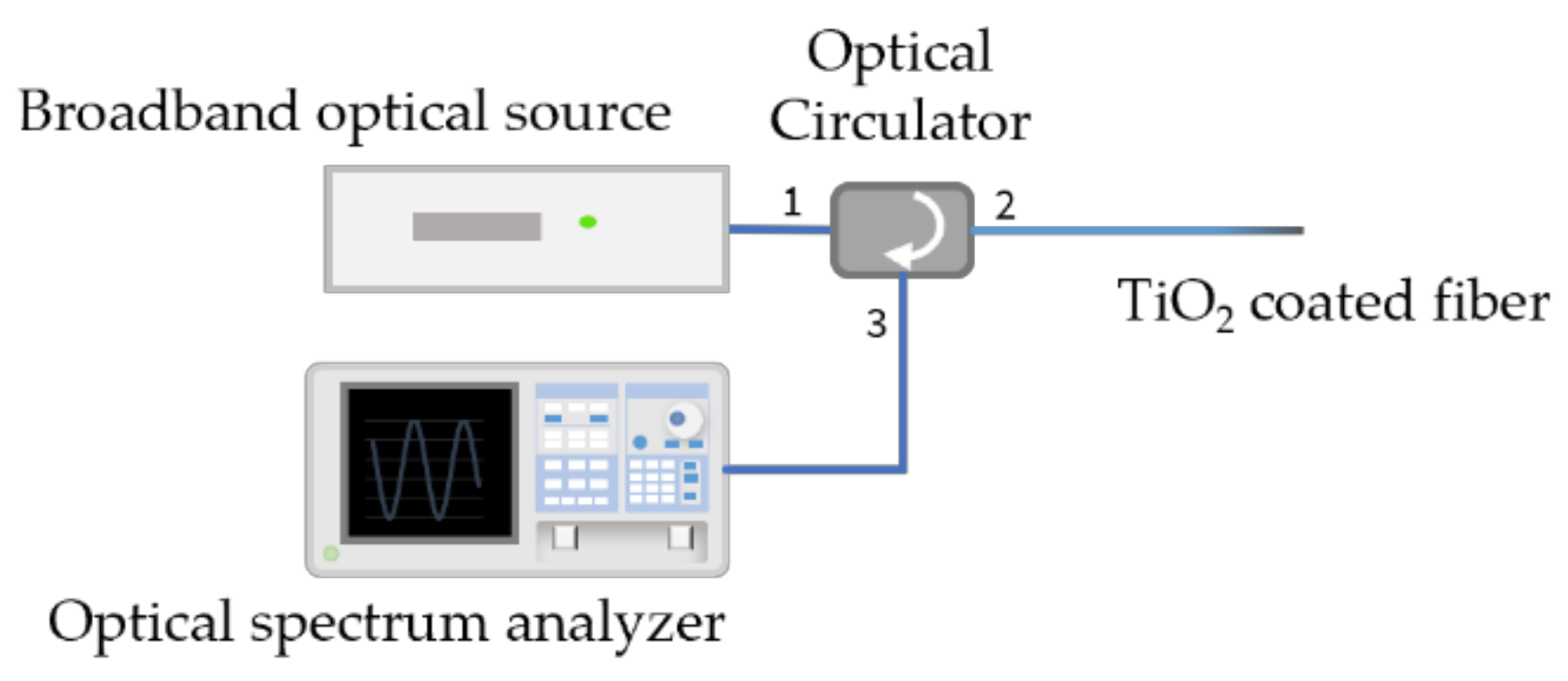
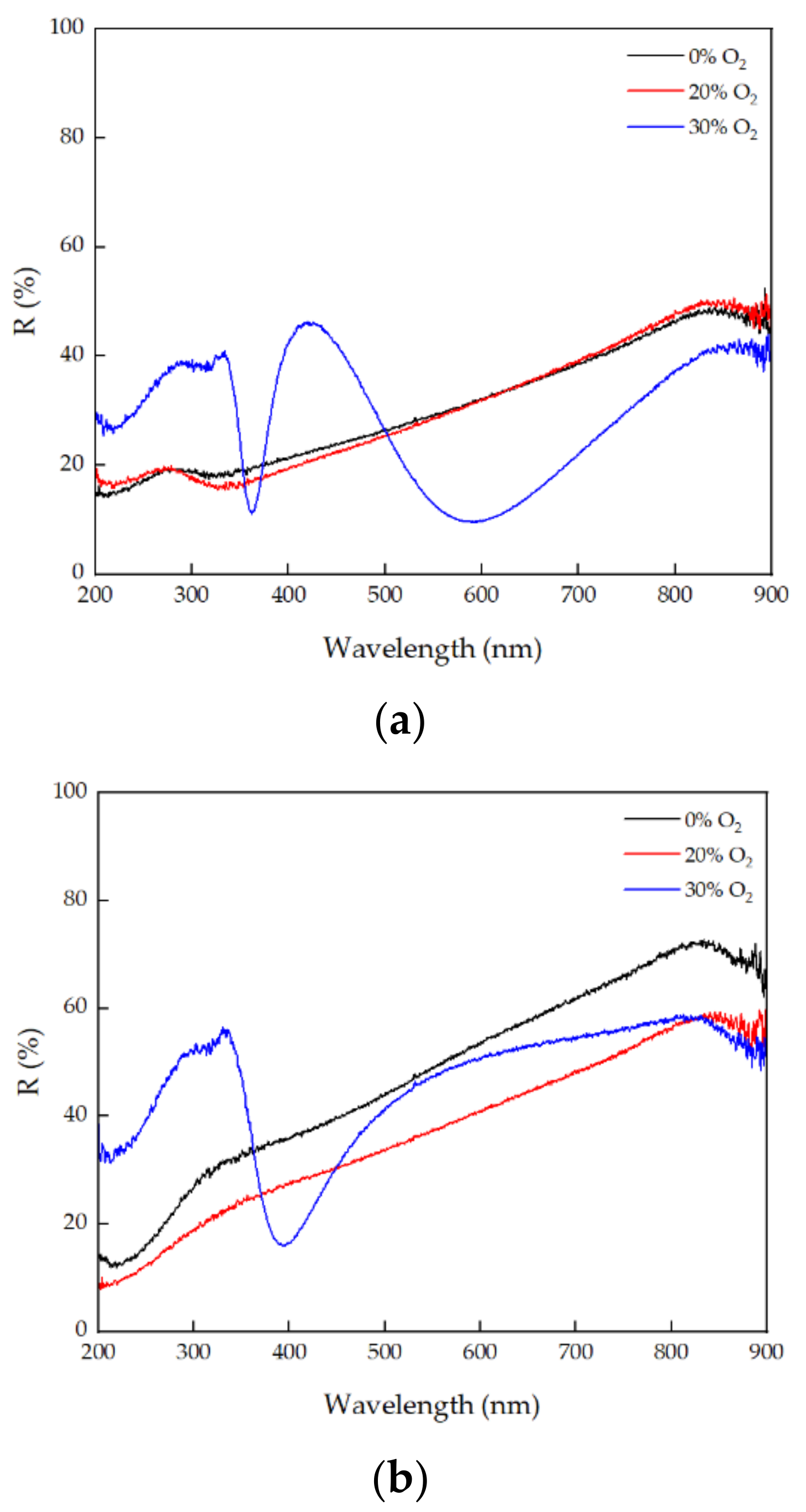

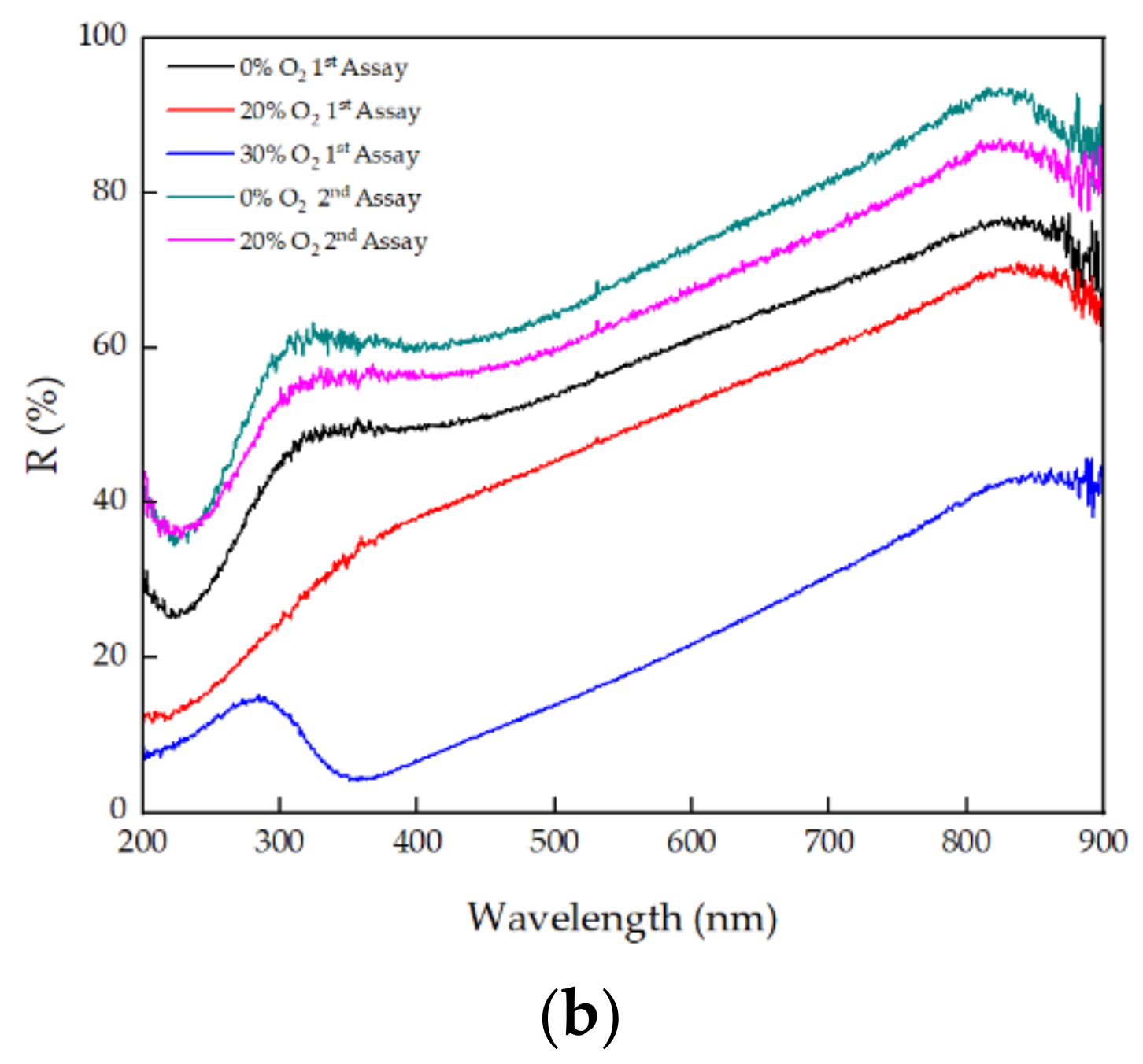
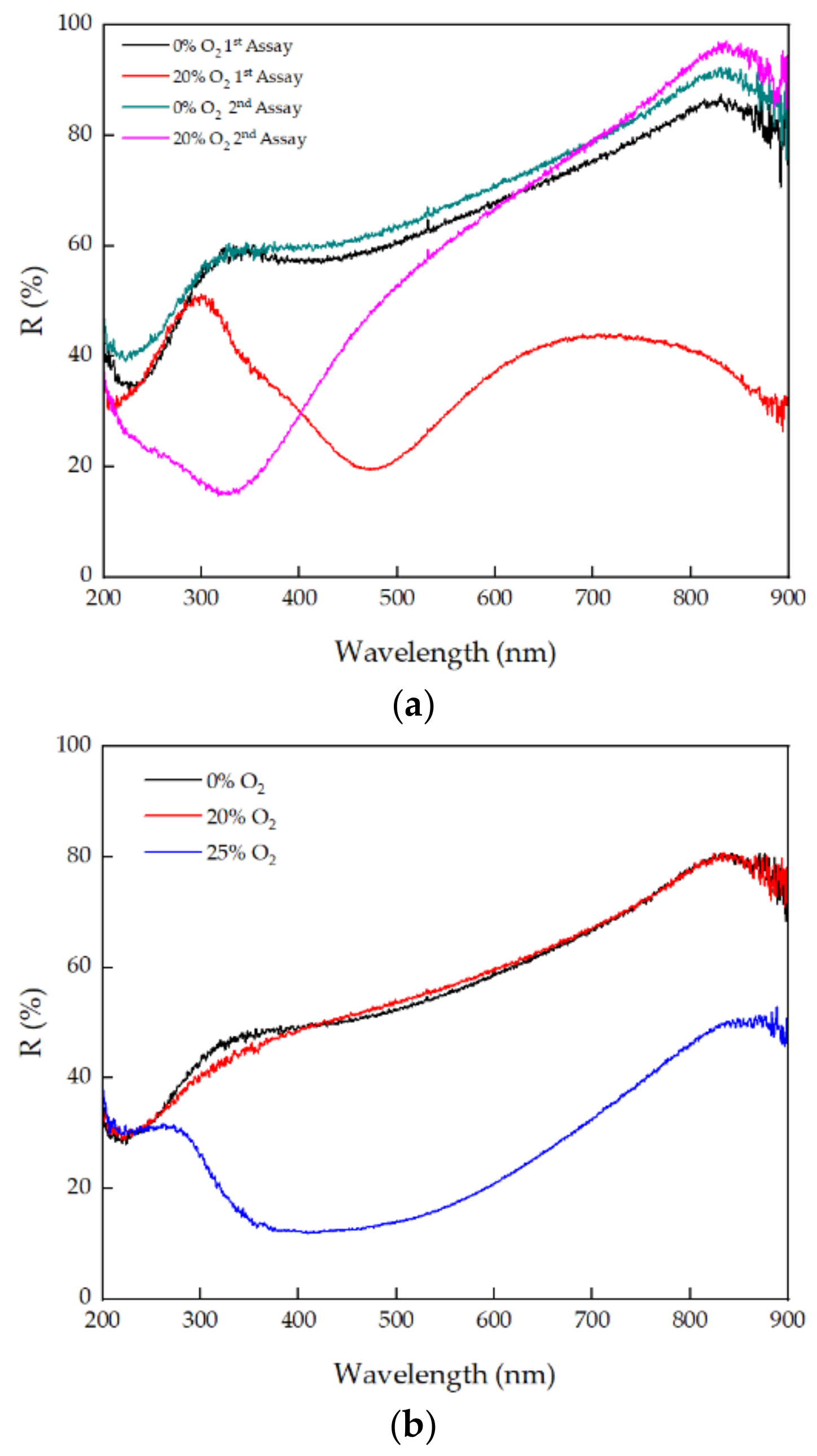
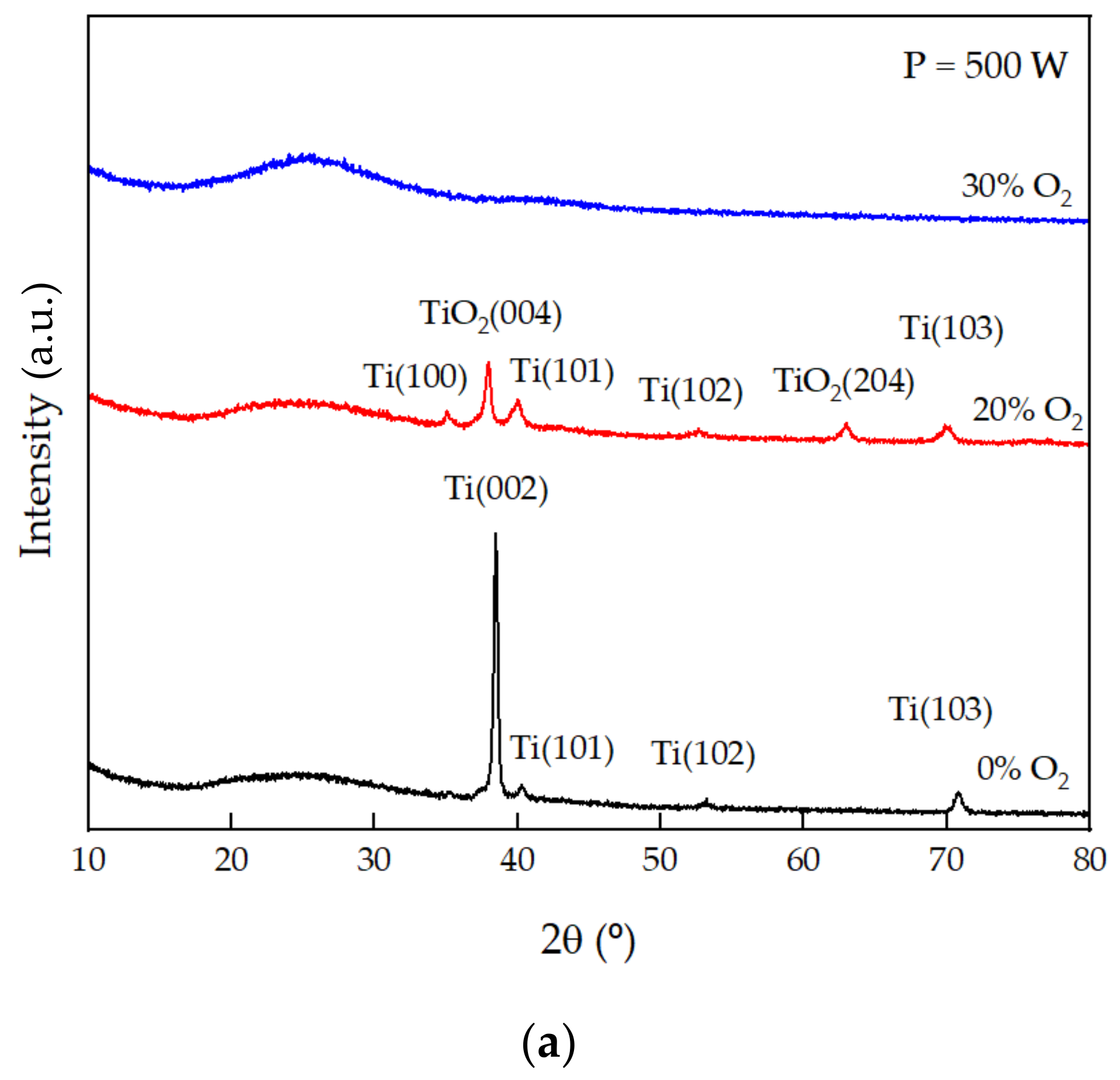
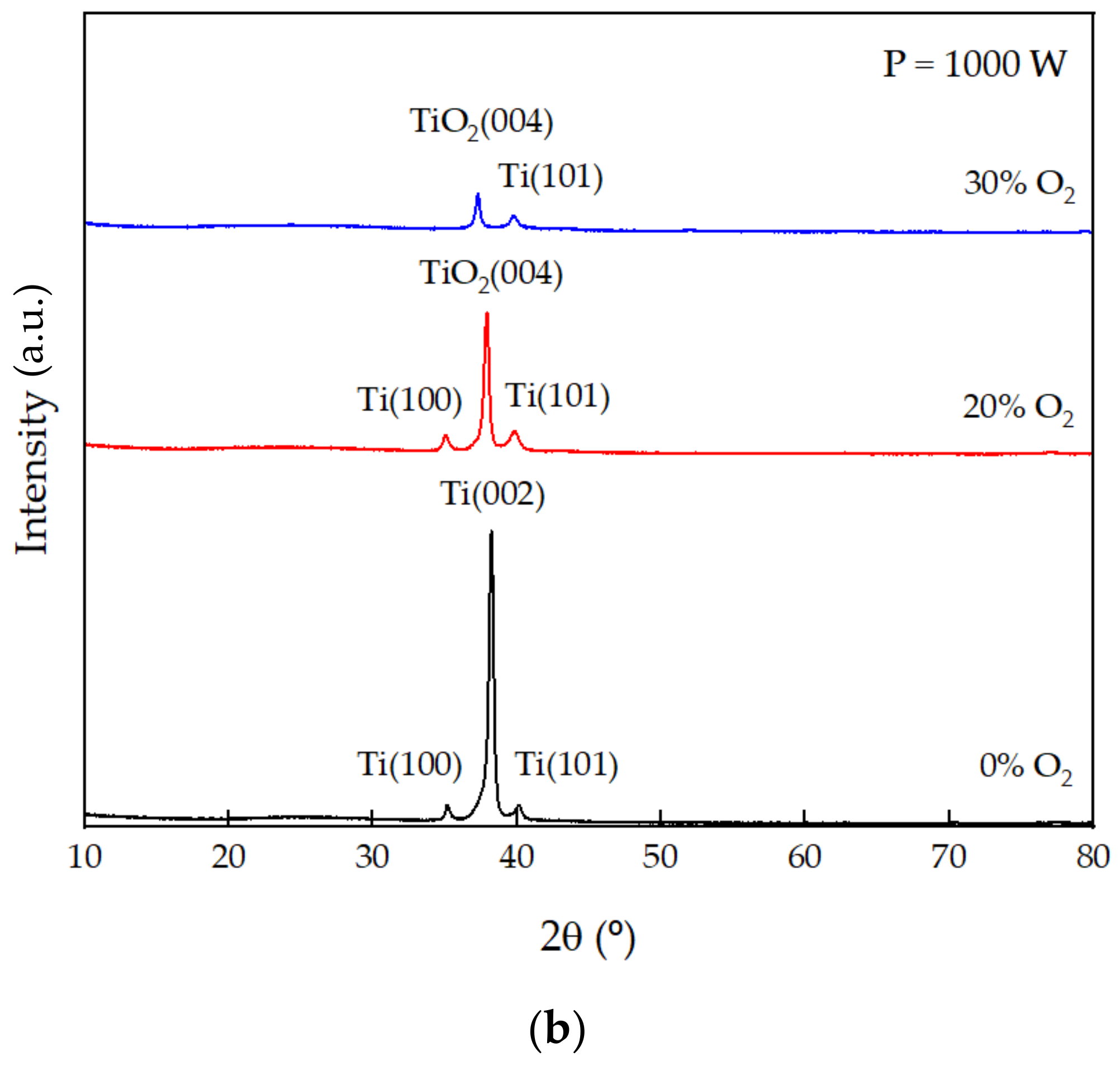
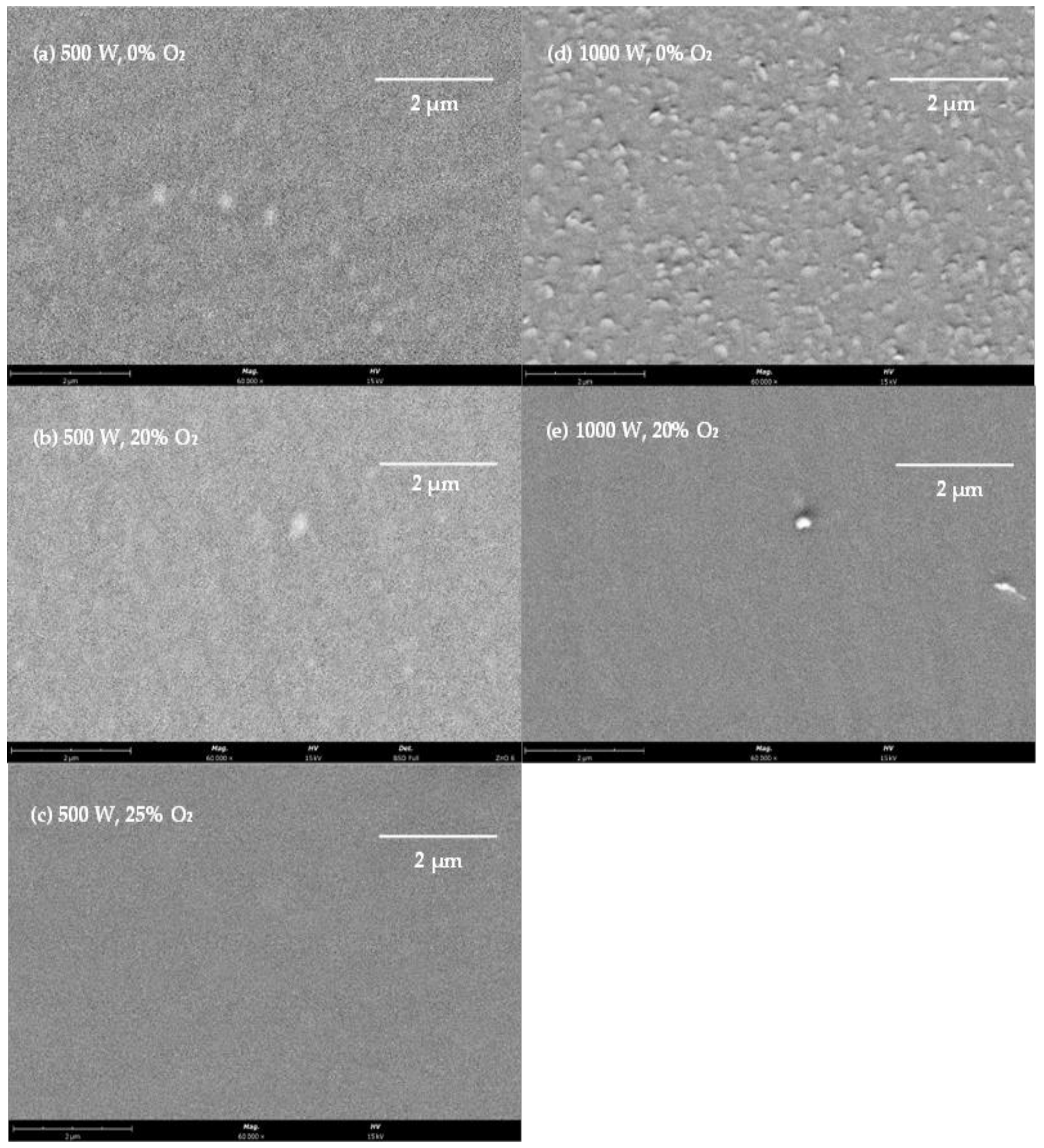
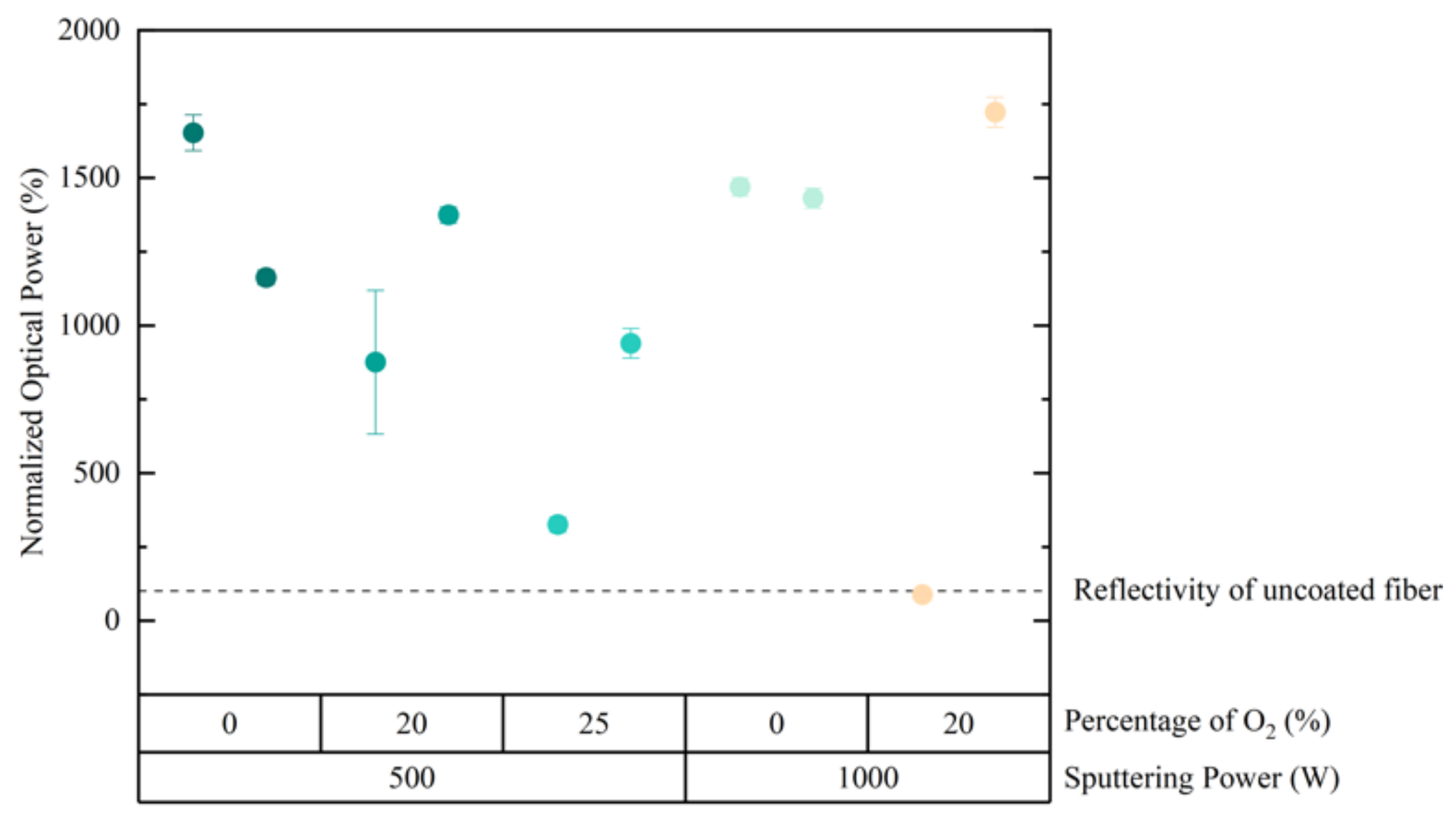
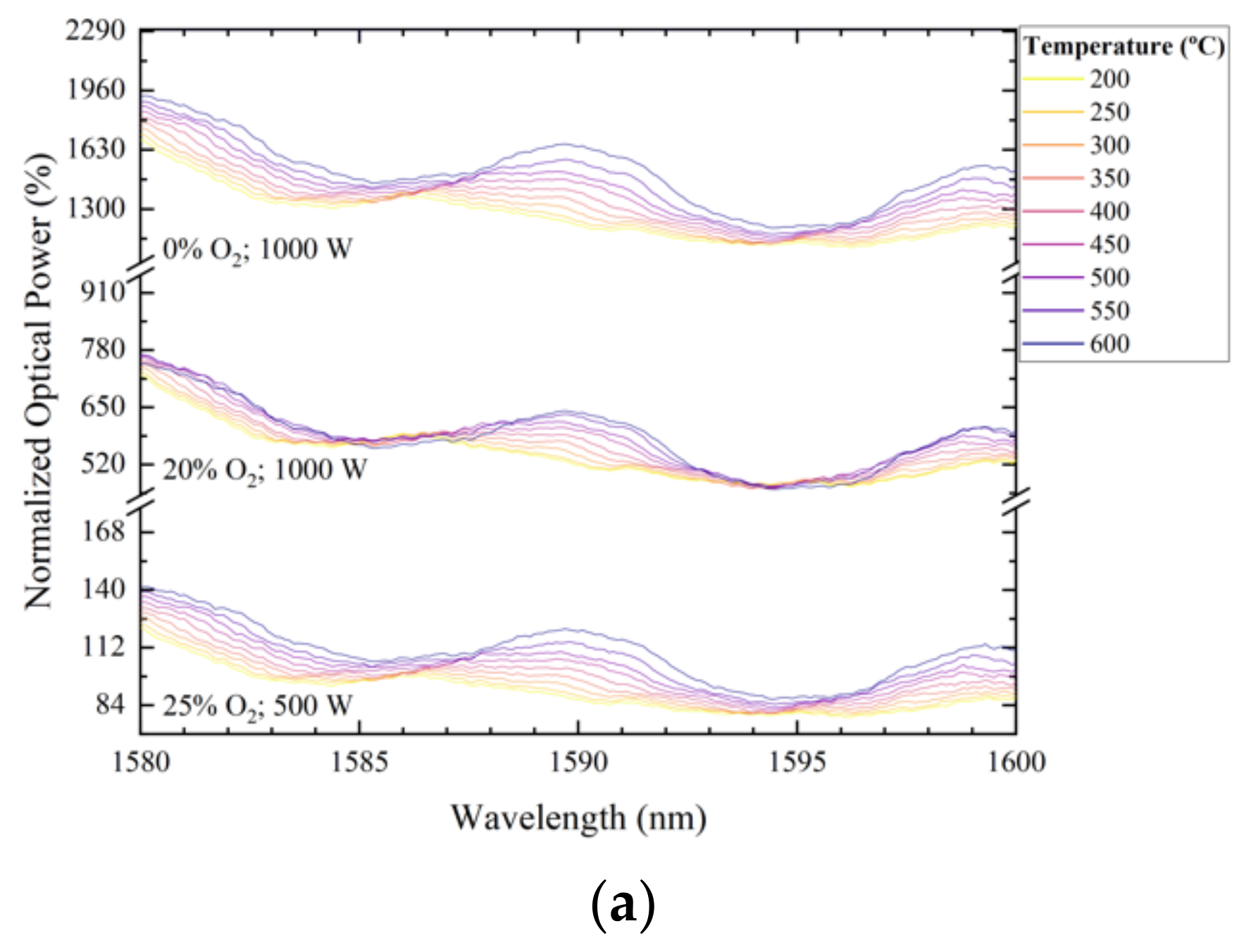
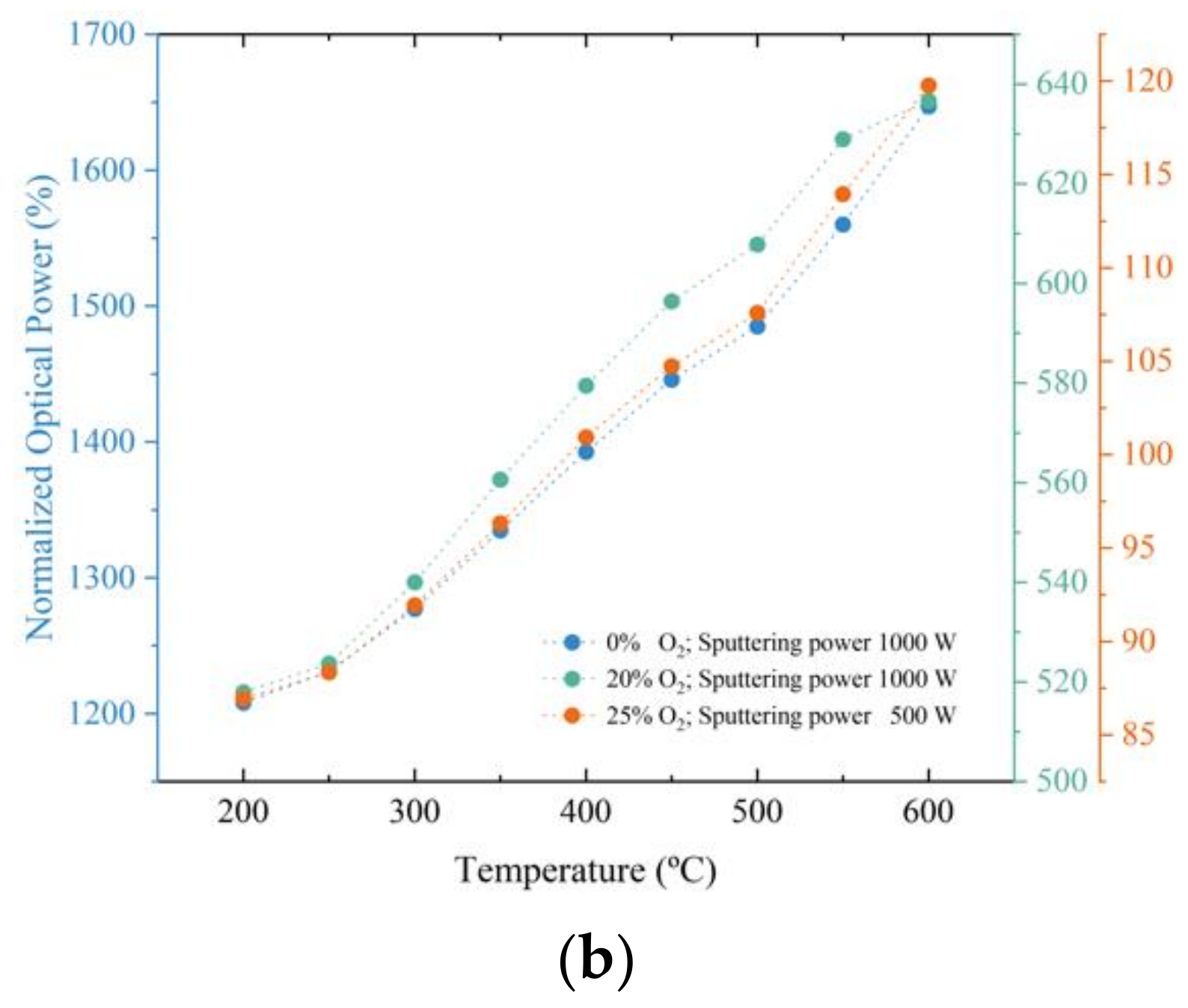

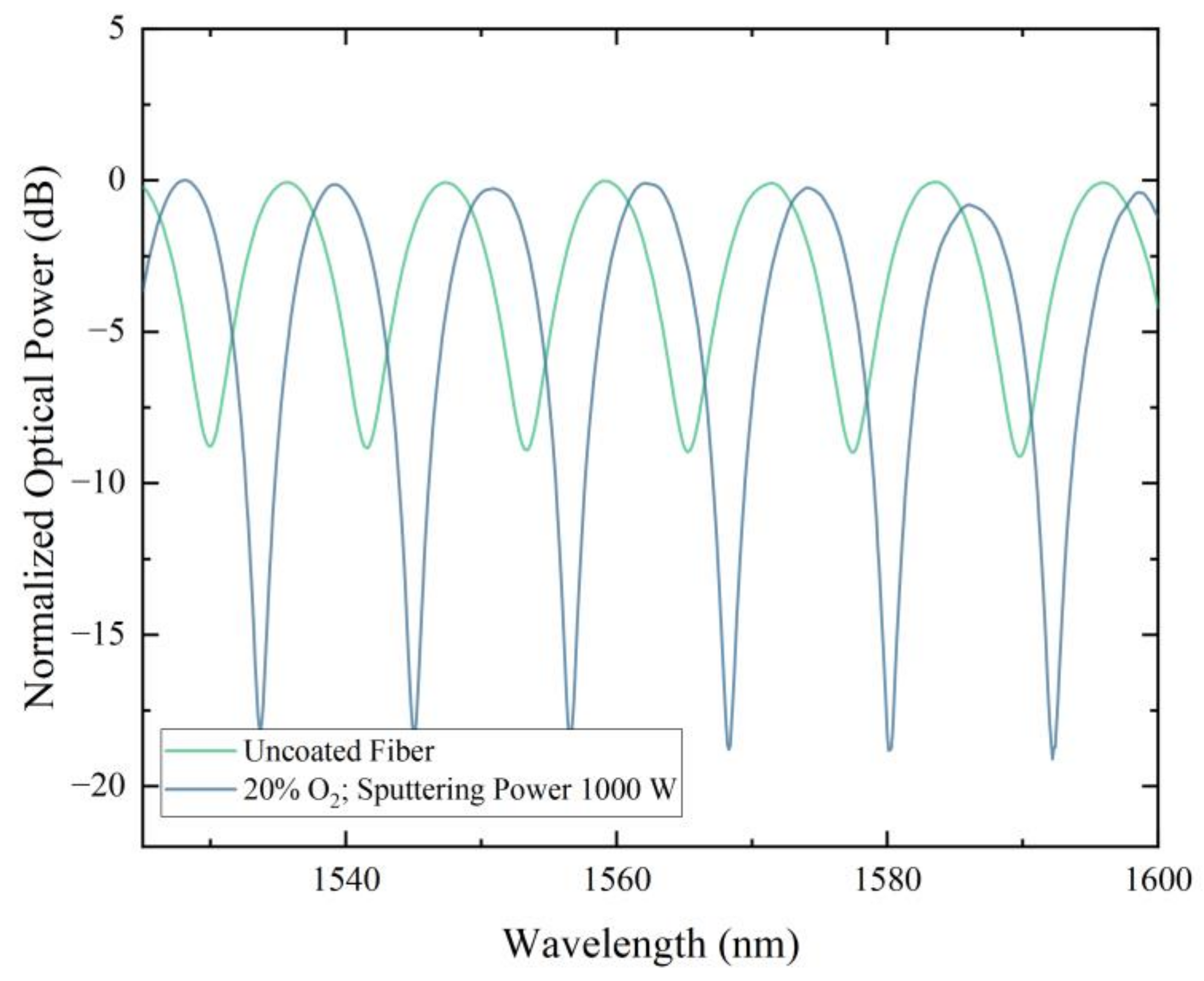
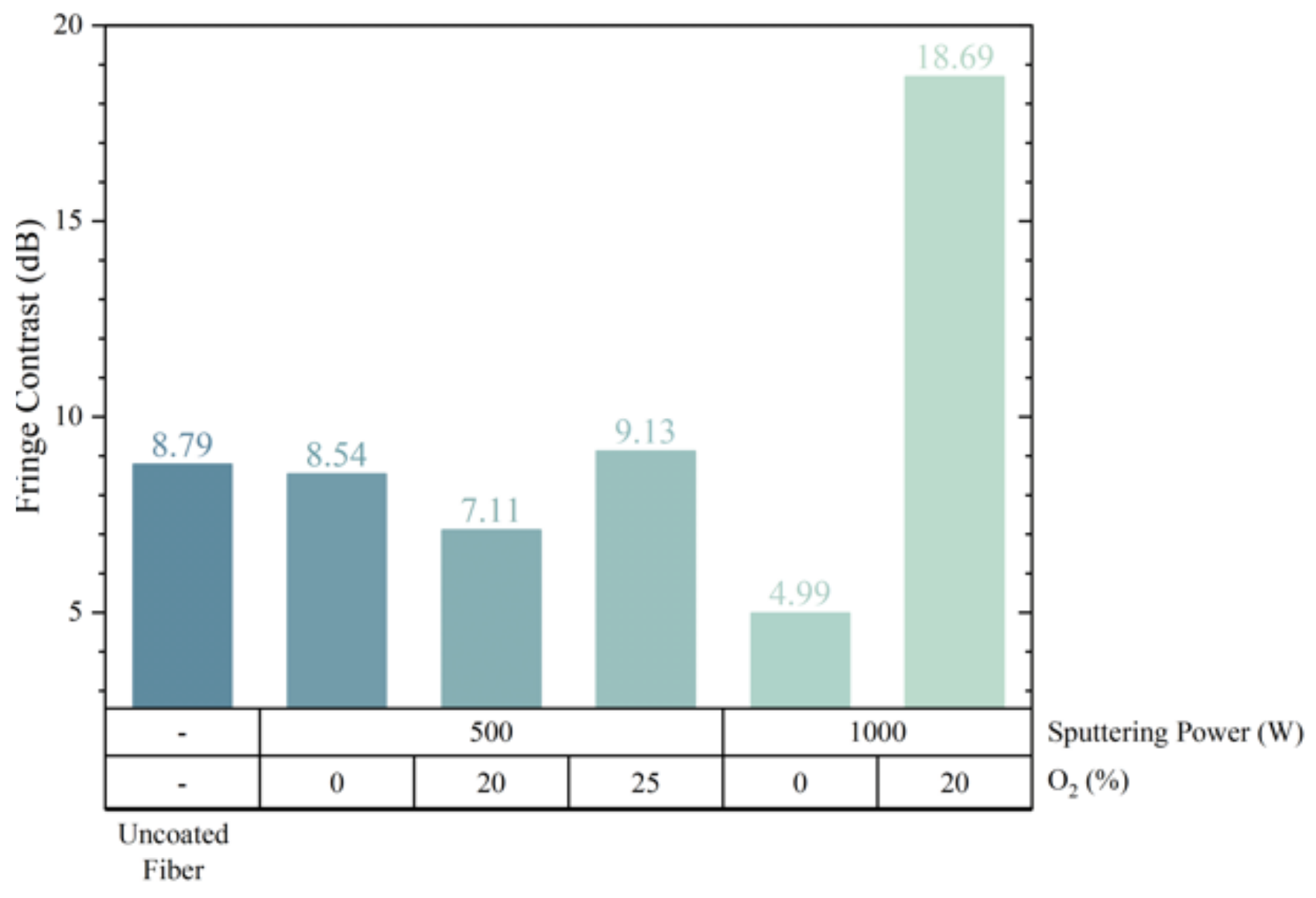
| O2 (%) | PT (Pa) | P (W) | U (V) | I (A) | t (min) |
|---|---|---|---|---|---|
| 0 | 0.80 | 530 | 238 | 1.87 | 15 |
| 20 | 0.80 | 540 | 302 | 1.78 | 15 |
| 25 | 0.81 | 540 | 302 | 1.78 | 15 |
| 30 | 0.82 | 540 | 400 | 1.34 | 15 |
| 0 | 0.81 | 1020 | 330 | 3.10 | 15 |
| 0 | 0.82 | 1040 | 310 | 3.34 | 15 |
| 20 | 0.82 | 1020 | 330 | 3.10 | 15 |
| 20 | 0.81 | 1020 | 248 | 4.12 | 15 |
| 30 | 0.81 | 1040 | 310 | 3.34 | 15 |
| 0 | 1.00 | 540 | 330 | 1.63 | 15 |
| 20 | 1.00 | 540 | 310 | 1.73 | 15 |
| 30 | 1.00 | 550 | 369 | 1.48 | 15 |
| 0 | 1.00 | 1020 | 330 | 3.10 | 15 |
| 20 | 1.00 | 1040 | 357 | 2.90 | 15 |
| 30 | 1.00 | 1040 | 341 | 3.05 | 15 |
Publisher’s Note: MDPI stays neutral with regard to jurisdictional claims in published maps and institutional affiliations. |
© 2022 by the authors. Licensee MDPI, Basel, Switzerland. This article is an open access article distributed under the terms and conditions of the Creative Commons Attribution (CC BY) license (https://creativecommons.org/licenses/by/4.0/).
Share and Cite
Silva, D.; Monteiro, C.S.; Silva, S.O.; Frazão, O.; Pinto, J.V.; Raposo, M.; Ribeiro, P.A.; Sério, S. Sputtering Deposition of TiO2 Thin Film Coatings for Fiber Optic Sensors. Photonics 2022, 9, 342. https://doi.org/10.3390/photonics9050342
Silva D, Monteiro CS, Silva SO, Frazão O, Pinto JV, Raposo M, Ribeiro PA, Sério S. Sputtering Deposition of TiO2 Thin Film Coatings for Fiber Optic Sensors. Photonics. 2022; 9(5):342. https://doi.org/10.3390/photonics9050342
Chicago/Turabian StyleSilva, Daniela, Catarina S. Monteiro, Susana O. Silva, Orlando Frazão, Joana V. Pinto, Maria Raposo, Paulo A. Ribeiro, and Susana Sério. 2022. "Sputtering Deposition of TiO2 Thin Film Coatings for Fiber Optic Sensors" Photonics 9, no. 5: 342. https://doi.org/10.3390/photonics9050342
APA StyleSilva, D., Monteiro, C. S., Silva, S. O., Frazão, O., Pinto, J. V., Raposo, M., Ribeiro, P. A., & Sério, S. (2022). Sputtering Deposition of TiO2 Thin Film Coatings for Fiber Optic Sensors. Photonics, 9(5), 342. https://doi.org/10.3390/photonics9050342










